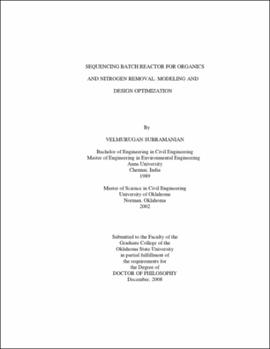| dc.contributor.advisor | Veenstra, John N. | |
| dc.contributor.author | Subramanian, Velmurugan | |
| dc.date.accessioned | 2013-12-10T18:05:34Z | |
| dc.date.available | 2013-12-10T18:05:34Z | |
| dc.date.issued | 2008-12 | |
| dc.identifier.uri | https://hdl.handle.net/11244/7838 | |
| dc.description.abstract | Scope and Method of Study: The overall research goal of this study is to develop an optimization model for the design of SBR with a new process model that describes the process adequately with as few parameters as possible to predict the performance well under all operating conditions. Developed process model was calibrated and validated prior to its use in the optimization model. The data for model calibration and validation were obtained from the operation of a full-scale 836 m3 /h (5.3 MGD) SBR system at the City of Tahlequah, Oklahoma. A calibration methodology was also presented for determination of unknown kinetic and stoichiometric parameters using an optimization technique called Simulated Annealing. Using the calibrated model, a model-based design methodology has been presented, and applied to the full-scale SBR for comparison with the existing conventional design. The proposed design methodology was, then, extended to design optimization model by including the capital and operating cost in the objective function. The objective function was then minimized with the same optimization technique, Simulated Annealing, subject to operational and process constraints. The results from the optimal design were, then, compared with the existing design. For the benefit of the existing SBR system, optimal operational strategies were also developed for energy savings. | |
| dc.description.abstract | Findings and Conclusions: The model predictions described reasonably well the trend of biodegradable organics removal, nitrification during aeration, and denitrification during the anoxic period. The model-predicted concentrations for NH4-N were within 0.03 mg/L and 0.61 mg/L from experimental values, and the average deviation was 0.29 mg/L. The average deviation for NO3-N from the experimental value was 0.23 mg/L. The model-predicted concentrations for BOD5 were generally between 0.5 mg/L and 1.8 mg/L except for two samples which are suspected outliers. Results from this work substantiate that use of model-based design approach or design optimization can reduce the cost of SBR system by about 10 to 20 percent of the life cycle cost and also reduce the volume of the reactor by about 30 percent compared to the conventional design approach. These reductions in volume and cost are significant and can make the SBR system more attractive to larger installations. | |
| dc.format | application/pdf | |
| dc.language | en_US | |
| dc.rights | Copyright is held by the author who has granted the Oklahoma State University Library the non-exclusive right to share this material in its institutional repository. Contact Digital Library Services at lib-dls@okstate.edu or 405-744-9161 for the permission policy on the use, reproduction or distribution of this material. | |
| dc.title | Sequencing batch reactor for organics and nitrogen removal: Modeling and design optimization | |
| dc.contributor.committeeMember | Clarkson, William W. | |
| dc.contributor.committeeMember | High, Karen A. | |
| dc.contributor.committeeMember | McTernan, William F. | |
| dc.contributor.committeeMember | Wilber, Gregory G. | |
| osu.filename | Subramanian_okstate_0664D_10092.pdf | |
| osu.accesstype | Open Access | |
| dc.type.genre | Dissertation | |
| dc.type.material | Text | |
| dc.subject.keywords | design optimization | |
| dc.subject.keywords | model calibration | |
| dc.subject.keywords | model- based design | |
| dc.subject.keywords | organics and nitrogen removal | |
| dc.subject.keywords | sequencing batch reac | |
| thesis.degree.discipline | Civil Engineering | |
| thesis.degree.grantor | Oklahoma State University | |
